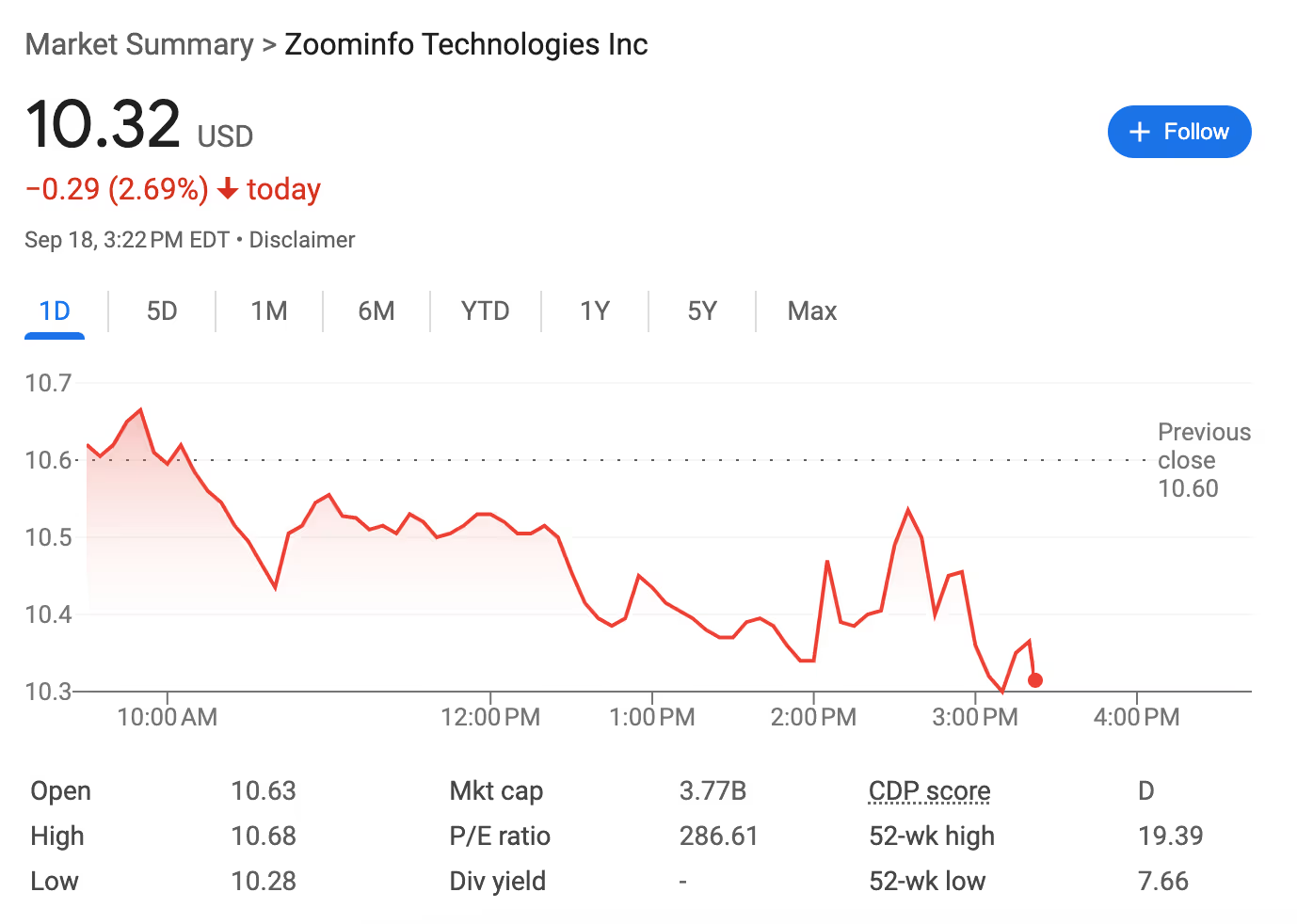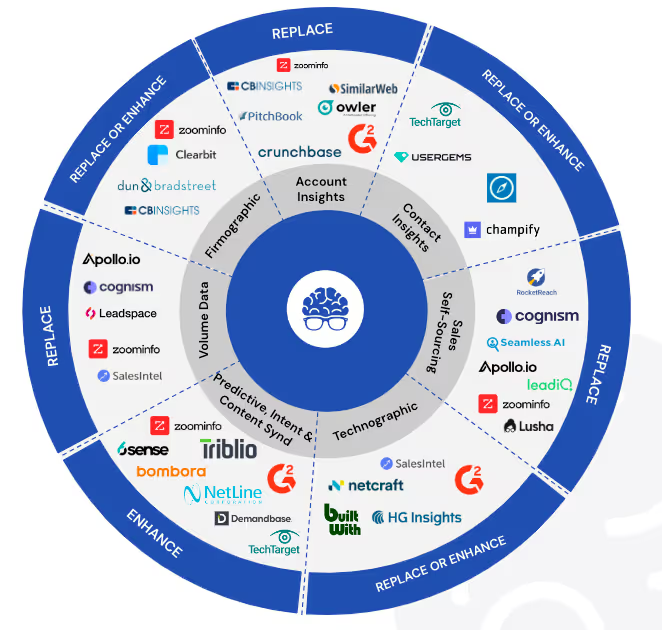ZoomInfo Technologies once reigned supreme in the realm of B2B contact and business information. Founded on a vast database of contacts, the company rode the wave of demand for digital business information through the pandemic, growing its client base and revenues at an impressive pace. As the world shifted to remote work, companies scrambled for reliable contact data, and ZoomInfo delivered in spades. However, as with many companies that rise too quickly, the cracks in the foundation eventually became too large to ignore.
The Rise: ZoomInfo's Domination
From its IPO in June 2020, ZoomInfo rapidly became the go-to data provider for sales and marketing teams across industries. Its extensive database of business contacts promised to give users a direct line to decision-makers, and the platform’s user-friendly interface made it an attractive solution for companies looking to scale their outbound sales efforts. Companies that needed a quick, off-the-shelf solution turned to ZoomInfo for its ready-to-go business data.
But there was always an undercurrent of skepticism. Could a one-size-fits-all database really provide the precision and insights needed for complex B2B sales motions? ZoomInfo's reliance on static, pre-built data led to early questions about the quality and freshness of its data, but those concerns were muted by the sheer utility the platform offered during a time of unprecedented disruption.
The Pandemic Boost
ZoomInfo’s meteoric rise was fueled by an unexpected catalyst: the COVID-19 pandemic. As companies pivoted to remote work, the demand for digital contact information surged. Businesses that had never heavily invested in outbound sales tools suddenly needed platforms like ZoomInfo to access remote decision-makers. The company capitalized on this wave, seemingly unstoppable.
For a while, everything was going ZoomInfo’s way. But the problem with pandemics is that they eventually end, and the pent-up demand that had accelerated ZoomInfo’s growth started to vanish. Without the tailwinds of the pandemic, the company’s underlying weaknesses became glaringly apparent.
The Fall: Auto-Renew Policies, Lawsuits, and Customer Backlash
By late 2022, cracks in ZoomInfo’s growth story started to show. ZoomInfo’s auto-renew policies became a major point of contention. Many customers, having signed up for ZoomInfo’s services during the pandemic boom, found themselves trapped in contracts they no longer wanted or needed. To make matters worse, ZoomInfo was accused of using coercive renewal tactics, leading to a growing sense of distrust among its customer base.
ZoomInfo's financial troubles became more public with each earnings call, with customer attrition, shrinking contracts, and reduced renewals painting a bleak picture. The company’s net revenue retention began to slip, and by 2024, ZoomInfo had taken multiple hits. Class-action lawsuits emerged, alleging that ZoomInfo’s revenue figures were inflated and its aggressive renewal policies had damaged long-term relationships with customers.
Enter Real-Time Data: The Rise of LeadGenius and Clay
As ZoomInfo struggled, a new wave of competitors emerged, offering something ZoomInfo couldn’t: real-time, bespoke data. Companies like LeadGenius and Clay took advantage of ZoomInfo’s reliance on static datasets, which were quickly becoming outdated in a world where information was changing by the minute.
LeadGenius, in particular, has pioneered a new approach to data collection, leveraging custom insights and real-time account signals that go beyond traditional firmographic and contact information. Instead of selling a pre-built database, LeadGenius provides data that’s tailored to a company’s specific needs, pulling in dynamic signals like new funding, product launches, strategic hires, and even social media trends. This flexibility allowed companies to not only reach the right contacts but also engage with prospects at the most opportune moments.
Meanwhile, platforms like Clay have made it easier than ever for teams to gather real-time data from the web, integrating data collection directly into workflows and allowing teams to scrape, verify, and use real-time insights in seconds. This DIY approach appeals to a new generation of marketers and sales professionals who want full control over their data pipeline without relying on outdated, monolithic databases.
Why Real-Time Data Wins
The advantage of real-time data providers like LeadGenius and Clay lies in their flexibility and precision. ZoomInfo’s static data model may have sufficed during the early 2020s, but today’s B2B landscape demands up-to-date insights, not just names and email addresses. Companies that once relied on ZoomInfo found themselves paying for data that was increasingly irrelevant, especially as their customers’ needs and buying processes evolved in real time.
In contrast, real-time data solutions provide businesses with the ability to gather insights as they happen. Whether it’s the launch of a new product, a sudden leadership change, or the opening of a new office, real-time data gives companies the chance to act fast and engage prospects at critical moments. This kind of proactive, on-demand approach has proven far more valuable to companies that are looking to maximize the effectiveness of their sales and marketing efforts.
ZoomInfo's Future: Adapt or Fade Away
With lawsuits mounting and revenues declining, ZoomInfo is now at a crossroads. The company can either double down on its legacy business model, or it can pivot and try to compete in the real-time data space. But for many, it may already be too late. The new wave of data providers is growing stronger by the day, and ZoomInfo’s static data model feels increasingly antiquated in the face of more agile competitors.
As businesses demand more customized, real-time insights, ZoomInfo’s days of domination may be coming to an end. The rise of companies like LeadGenius and Clay signals a shift in the B2B data landscape, one where flexibility, precision, and real-time insights are paramount. ZoomInfo may have been the king of the last decade, but in a world where data is everything, staying still is no longer an option.




